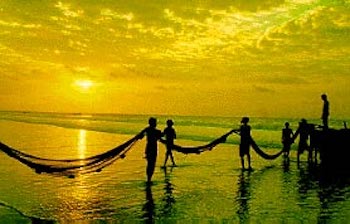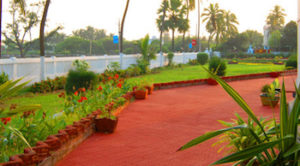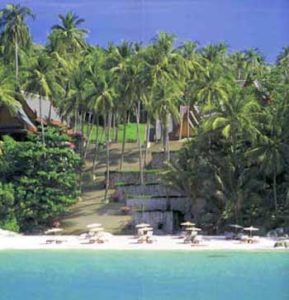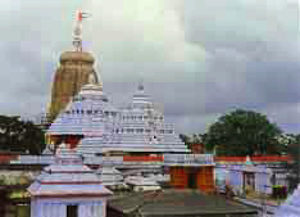
Sumanta Roy Chowdhury is an intrepid traveller and regular trekker with several high altitude treks to his credit. A keen photographer, he shoots both still and video. Here he shares his impressions of Puri.
One would have to be extremely fortuitous to find a Bengali who hasn’t visited Puri at least once. Rarely does one come across a place outside Bengal that is so closely associated with the Bengali ethos. I have lost count of how many times I have visited Puri. From Kolkata it is convenient to travel by Jagannath Express which leaves at 7 p.m., a very convenient time for those who want to travel on weekends. As dawn breaks, you will find your train pulling into Puri station. There is another train, Puri Express which leaves late and is generally used by passengers who spill over during peak tourist season.
The sea beach is really within walking distance from most locations but people generally prefer cycle rickshaws. Puri has accommodation to suit every pocket and taste. There are dharamshalas near the temple, Holiday Homes of various companies and hotels of all types.
 Old aristocratic Bengalis will swear by BNR Hotel (named after the Bengal Nagpur Railway and currently known as Chanakya BNR Puri) when it comes to comfort, sumptuous meals and nostalgia about the Raj. Although the rooms are not airy, it is a pleasure to sit in the wide veranda and read a book. However, there is very little sea view as the hotel is recessed from the sea beach.
Old aristocratic Bengalis will swear by BNR Hotel (named after the Bengal Nagpur Railway and currently known as Chanakya BNR Puri) when it comes to comfort, sumptuous meals and nostalgia about the Raj. Although the rooms are not airy, it is a pleasure to sit in the wide veranda and read a book. However, there is very little sea view as the hotel is recessed from the sea beach.
The beach can be divided in two parts. Chanakya BNR is in the more secluded part called Chakratirtha Road. The other side is called Swargadwar (Gateway to Heaven). Swargadwar has a beach road running for about quarter of a kilometre starting from the Burning Ghat, which accounts for the name. All the budget hotels are on this road including Puri Hotel, which claims to be the largest middle class hotel in town. Without exception, all the hotels offer good service and value for money.
We stayed at Victoria Club Hotel, which was started in 1907 and claims to be the oldest residential hotel in Puri. Over the years the owners have added new blocks to the sprawling complex integrating the old with the new. Our rooms were in the newest block. The balconies overlook the sea at an angle that allows the sun to hit the room only in the late afternoon. The rooms are large and airy and were excellent value for money.
 The first thing any visitor to this town will do is to head for the sea for a splash or swim. A unique feature of this town is the presence of ‘Nuliahs’ who can be roughly equated to the bay watchers in the West. For a fee they will take you a little deep in the water for a great experience. They also come very handy in any emergency. During our visit the sea was rough, the sand was very soft and only a few bathers could be seen.
The first thing any visitor to this town will do is to head for the sea for a splash or swim. A unique feature of this town is the presence of ‘Nuliahs’ who can be roughly equated to the bay watchers in the West. For a fee they will take you a little deep in the water for a great experience. They also come very handy in any emergency. During our visit the sea was rough, the sand was very soft and only a few bathers could be seen.
The name Puri comes from Jagannath Puri or the abode of Lord Jagannath. The temple occupies central pride of place in the town. Walks in the narrow lanes around the temple make one realise that the sea was inconsequential to the early growth of the town. Everything grew around this magnificent piece of architecture. The main temple is one of the tallest monuments in the country rising to 214 feet with a raised platform measuring 10 acres.
There were more than 700 Maths (religious institutions) around the temple complex but as the town became more and more of a beach resort their numbers dwindled and only about a dozen survive now. Things haven’t changed much in the lanes that lead to the temple. casual walk through them rewards one with glimpses at old ways of life. Houses on both sides are built on raised platforms of stones and religious figures and stone carvings abound. Every house has some sort of a temple with the size often reflecting the affluence of the owner. There is an intoxicating smell of incense sticks, mixed with butter emanating from the lamps in temple and the sweet shops that line the lanes. The place has a character of its own and offers a taste of an India that is fast vanishing.
 Cameras are not allowed inside the temple. So, in order to take a picture, I was looking for a way to the roof of a house opposite the temple. A narrow staircase concealed between rows of shops selling ‘Khajas’ (a local sweet) and Orissa Handloom products took me to the first floor. To my amazement it turned out to be the reading room of a public library. The place had a terrific old world charm about it. There were pictures of visits by the Viceroy in 1945 and leather bound books in wooden racks. A huge reading table dominated the central part of the room; the place was unusually quiet. An old gentleman was reading an Oriya daily, sunrays falling through the window creating a halo around his white hair. I looked for a window from which to take a picture but found none.
Cameras are not allowed inside the temple. So, in order to take a picture, I was looking for a way to the roof of a house opposite the temple. A narrow staircase concealed between rows of shops selling ‘Khajas’ (a local sweet) and Orissa Handloom products took me to the first floor. To my amazement it turned out to be the reading room of a public library. The place had a terrific old world charm about it. There were pictures of visits by the Viceroy in 1945 and leather bound books in wooden racks. A huge reading table dominated the central part of the room; the place was unusually quiet. An old gentleman was reading an Oriya daily, sunrays falling through the window creating a halo around his white hair. I looked for a window from which to take a picture but found none.
A man emerged from behind a bookrack and looked at my camera. Without a word he took out an old register and asked me to sign. I noticed that people had paid ten rupees for photography. After signing he simply pointed me to a door and said softly “lock the doors as you come down”. I found a flight of stairs that led to the roof – the view was amazing. I realised that I was on the third floor of the house and was still lower than the elevated platform on which the temple was built. I again felt that the real Puri was before me.
As for the beachfront, it has grown haphazardly. There are restaurants with no sea view, and shops selling liquor, but no bar where one can sit and watch the sea. New developments have taken place along the newly constructed Marine Drive where tradition has been given a quiet burial. This is growing to be be a sea side town with all amenities but the charm of Puri as old-timers knew it, will have been lost.

Thanks for this information